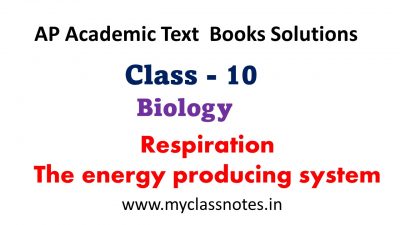Ap Class 10 Respiration Notes – Respiration-The energy producing system Complete text book notes here. Ap Class X Respiration The energy producing system Notes. respiration class 10 notes pdf, respiration in human beings class 10 notes pdf, notes of respiration class 10, class 10 respiration notes class 10 biology respiration notes, respiration class 10 notes pdf ssc, nutrition and respiration class 10 notes

Ap Class 10 Respiration Notes
Ap Class 10 Respiration Notes – Key Points
By “respiratory system” we usually mean the passages that transport air to the lungs and to themicroscopic air sacs in them, called alveoli (where gases are exchanged) and vice versa.
• The term ‘respiration’ refers to the whole chain of processes from the inhalation of air to the use of oxygen in the cells.
• Lavoisier found that the air that we breathe out precipitated lime water
• Air passes from nostrils to nasal cavity to pharynx, larynx, trachea, and bronchi, bronchioles to alveoli and blood and back through the same route.
• Gas exchange in the lungs takes place in the tiny air sacs called alveoli in the lungs. The lungs have millions of alveoli and each lies in contact with capillaries.
• Diaphragm is a muscular tissue present at the floor of the chest cavity.
respiration class 10 notes pdf, respiration in human beings class 10 notes pdf, notes of respiration class 10, class 10 respiration notes class 10 biology respiration notes, respiration class 10 notes pdf ssc, nutrition and respiration class 10 notes
• During inspiration (inhalation) the volume of the chest cavity is increased as the diaphragm contracts and dome flattens out, its internal pressure decreases and the air from the outside rushes into the lungs.
Ap Class 10 Respiration Notes – Key Points
• During expiration, the chest wall is lowered and moves inward, and the diaphragm relaxes and assumes its dome shape. These changes increase the pressure on the lungs; their elastic tissue contracts and squeezes the air out through the nose to the external atmosphere.
• Air is filtered in the nasal cavity and the whole length of the trachea.
• The moist surface of the lining of the nasal cavity, and the hairs growing from its sides, remove some of the tiny particles of dirt in the air. In addition, as the inhaled air passes through the nasal cavity, its temperature is brought close to that of the body, and it takes up water vapour. So that it becomes more moist than before.
• Pharynx is a common passage of digestive and respiratory system. Epiglottis, a flap like muscular valve controls movement of air and food towards their respective passages.
• Larynx is a stiff box like structure containing our vocal cords. When air passes out of the lungs and over the vocal cords, it causes them to vibrate. This produces sounds on the basis of our speech, song etc.
• Trachea is the wind pipe channeling air to lungs.
• At its lower end the trachea or the wind pipe divides into two bronchi-one leading to each lung.
Ap Class 10 Respiration Notes – Key Points
respiration class 10 notes pdf, respiration in human beings class 10 notes pdf, notes of respiration class 10, class 10 respiration notes class 10 biology respiration notes, respiration class 10 notes pdf ssc, nutrition and respiration class 10 notes
• The bronchi divide into smaller and smaller branches called bronchioles.
• These finally terminate in clusters of air sacs called alveolus in the lungs which are very small and numerous. Gaseous exchange takes place here as blood capillaries take up oxygen and expel carbon dioxide here.
• Aerobic respiration occurs in adequate supply of air producing a lot of energy, carbon dioxide and water.
• Anaerobic respiration and fermentation occurs in inadequate supply or absence of oxygen to produce
energy.
• Cells may resort to the breakdown of 3 carbon compound, pyruvate, aerobically or anaerobically depending upon the availability of oxygen. Usually in multicellular organisms cells fail to carry on the process of anaerobic respiration for long.
• Respiration is not essentially a process of combustion differ due to following reasons – Glucose must be burnt at high temperature in the laboratory to liberate energy, if it happened in our cells, all cells would be burnt.
– Once glucose starts burning we can’t stop the process easily, but living cells are able to exercise control over the sort of burning of glucose in the presence of oxygen.
– Water normally stops combustion from taking place while cells contain a lot of water and respiration still goes on.
• Photosynthesis and respiration appear to be opposing reactions, but both have very different biochemical pathways and are essential for a plant’s metabolism.
respiration class 10 notes pdf, respiration in human beings class 10 notes pdf, notes of respiration class 10, class 10 respiration notes class 10 biology respiration notes, respiration class 10 notes pdf ssc, nutrition and respiration class 10 notes
Ap Class 10 Respiration Notes – Key Points
• Photosynthesis takes place in the chloroplast to produce sugars, starches and other carbohydrates for the plant’s metabolic needs.
• Cellular respiration occurs in mitochondria where mainly these carbohydrates are “burned” to produce chemical energy to do work at the cellular level
For Chapter-1 Nutrition – Food supplying system Click here
respiration class 10 notes pdf, respiration in human beings class 10 notes pdf, notes of respiration class 10, class 10 respiration notes class 10 biology respiration notes, respiration class 10 notes pdf ssc, nutrition and respiration class 10 notes
